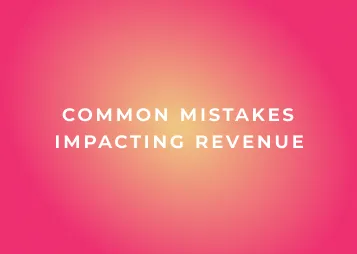Let me guess, your reps think you’ve got the easy job, right?
Setting sky-high targets they’ll struggle to achieve?
But being the one managing revenue is no walk in the park either.
The pressure to achieve growth never really goes away. And even with all the best intentions, RevOps and Sales leaders often fall into common traps that hinder their ability to achieve revenue success.
Here are the five most common mistakes I’ve seen impacting revenue and how you can overcome them.
#1 Not taking into account your sales cycle length
If years of working in revenue has taught me one thing - it’s to never overlook the nuances.
Every business and its sales cycle is totally unique. The time taken from lead generation to deal close varies significantly across industries and business models. Failing to consider this crucial factor when target setting will lead to unrealistic expectations and unnecessary pressure on your sales team. So check: do you have enough pipeline or enough time and ability to create enough pipeline to achieve the targets you are about to set?
Align your revenue targets with the actual timeline of your sales cycle - this should include any seasonality you are aware of too. Many industries experience fluctuations in demand during certain times of the year, and ignoring these variations in your targets can result in both unattainable goals and missed opportunities.
Take the time to analyze historical data, identify patterns, and adjust your goals.
#2 Setting targets higher than last year, just to show growth
While growth may well be a key objective for your organization next year, setting targets higher than the previous year solely for the sake of showcasing growth is like shooting yourself in the foot.
It might be what you’d like to achieve, in an ideal world, but if it’s not achievable, you’re playing a dangerous game. Unrealistic goals will demoralize your sales team, lead to burnout, and, ultimately, lead to worse overall performance.
Rather than relying on arbitrary growth percentages, base your revenue targets on a comprehensive analysis of market trends, customer demand, and the competitive landscape. Evaluate the growth potential of your existing accounts and identify expansion opportunities. Again, a more nuanced approach that aligns with market reality will not only set realistic expectations but also motivate your team to achieve meaningful and sustainable growth.
#3 Not planning for resources and headcount in advance
Effective revenue target setting goes beyond numbers; remember, it’s the teams of people sitting behind the numbers that will actually make that magic happen!
A holistic approach considers the resources and headcount required to meet those targets. Factor in hiring and rep ramp time, well in advance. Failure to plan for the necessary support systems leads to understaffing and inadequate training that will only impede your team's ability to generate revenue.
Before finalizing your revenue targets, assess your current team's capabilities and identify any skill gaps. Determine if additional training or hiring is necessary to meet the increased demands. Allocate resources strategically to areas that will have the most significant impact on revenue generation.
Also, revisit as you hire. Do you have enough time to hire and allow them to ramp to maintain target? Is there a business case to hire early if needed?
As an added bonus, align your hiring and training initiatives with your sales cycle. If your sales cycle is getting longer, invest in a team that excels in relationship-building and long-term account management. Being proactive in resource planning ensures that your team is equipped to handle the challenges posed by ambitious revenue targets.
#4 Not aligning the whole business to revenue and business goals
It’s not only the sales team who are responsible for revenue targets. Communicating with and aligning the entire organization to revenue and business goals is crucial - everyone should feel accountable. Siloed departments and conflicting priorities create friction. And friction hinders the flow of information and collaboration needed for defining and achieving revenue targets.
Break down internal barriers and emphasize the collective responsibility of each team in contributing to revenue generation. This alignment ensures that marketing, product development, customer service, and other departments work cohesively to support the sales team in achieving its targets.
Regularly communicating the progress towards revenue goals across the organization, will help all departments feel more involved and able to better address challenges and celebrate achievements. This approach creates a culture of accountability and shared success, propelling the entire company towards smashing those targets.
#5 Ignoring pipeline goals until after the revenue goals are set
Instant sales don’t grow on trees, unfortunately.
So don’t forget to establish clear pipeline goals alongside your revenue targets. The health of your sales pipeline directly influences your ability to meet revenue targets, and failure to address this will only lead to overambitious goals or highly disappointed reps.
Start by analyzing your historical conversion rates at each stage of the sales pipeline. Understanding the typical journey from lead generation to closed deal enables you to set realistic pipeline goals that align with your revenue targets. Factor in the expected conversion rates and adjust your pipeline goals accordingly.
And this isn’t just an activity when setting targets for the year ahead; you need to continually monitor and optimize your sales pipeline throughout the year. Identify bottlenecks, refine processes, and adapt to changes in the market. A well-managed pipeline not only enhances your ability to achieve revenue targets but may also provide valuable insights for future target setting.
And finally…
Managing revenue is a delicate balancing act, so here’s my top tips from my time working in operations and revenue management.
1) Be prepared - consider every resource or element that will be required to hit target. Check that these resources are available or accessible to you before committing to the numbers.
2) Fact check - listen to what your reps and teams are forecasting and question the how and the why. If the buck stops with you on managing revenue, it’s your responsibility to review the information given to you.
3) Be realistic - setting unrealistic targets won’t make you look good in the long run and might even impact your credibility within the organization.
4) Adapt - things change, and that’s ok, so be ready to pivot throughout the year as required. Get buy-in from the top of your organization to let you turn the ship with expertise if needed.
Ready for some fundamentals on sales techniques? Click here.
Dan Wilson is the Head of Revenue Operations at Jiminny, implementing new strategies and procedures to improve efficiency, performance, and customer satisfaction across the sales cycle and beyond. With over eight years in operations and five years with revenue teams, Daniel has managed and coached teams through numerous challenging situations. He is endlessly passionate about using data, insights and human interactions to drive business decisions and optimize business processes.





.webp)






